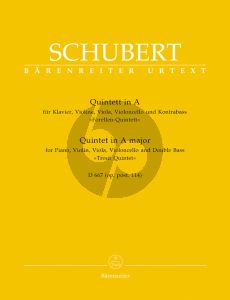During the summer months of the years 1819, 1823 and 1825, Schubert spent several weeks with his friend and interpreter of his lieder Johann Michael Vogl in Vogl's home town of Steyr in Upper Austria. Vogl made Schubert acquainted with the musical circles of the town, particularly with the home and circle of Sylvester Paumgartner, the musical patron of Steyr at that time.
In the 'music salon' of his home on the town square, Paumgartner regularly organized concerts, somewhat comparable to the Sonnleithner soirées in Vienna. Schubert's relations with Steyr and with Paumgartner in particular were vividly recounted by Schubert's friend Albert Stadler, who also came from Steyr, in his memorandums addressed to Ferdinand Luib in 1858. Stadler's report is the only source concerning the origin of the Quintet. 'You are probably familiar with Schubert's Quintet for pianoforte, violin, viola, violoncello and double bass with the variations on his 'Trout'. He wrote it at the express wish of my friend Sylvester Paumgartner, who was utterly enchanted with the delightful little song. He wanted the piece to have the form and scoring of Hummel's Quintet, recte Septet, still new at that time. Schubert finished the piece quickly and kept the score himself . . .'.
This account shows that the piece was written upon Paumgartner's suggestion, but gives no information about the time and place of composition. However, one can assume that Schubert composed it in 1819 for Steyr. Hummel's Septet in D minor Op.74 (for flute, oboe, horn, viola, violoncello, double bass and piano) had been published in 1816 and became available in a version for quintet with the same scoring as Schubert's Trout Quintet in the same year.
Schubert's score is lost, but the parts which Albert Stadler had 'furnished' and from which the performers most likely played at the first performance in Paumgartner's house in Steyr have been preserved (St. Florian monastery in Upper Austria). These parts transmit a version differing above all from the printed edition in that several passages are simpler. This version was published for the first time in the New Schubert Edition; it has been reproduced here as the main text. However, the first edition published by Josef Czerny in 1829 was also based on Schubert's score and it can be assumed that the alterations stem from the composer himself and not from the publisher.
These discrepancies between the first edition and the parts are given as well so that it is possible to play both versions with this one music text. In the evaluation of the variant readings between print and copy, one particular question takes on a special importance; which bass instrument did Schubert have in mind, the smaller violone (lowest string E') or the larger one (lowest string C'). Whereas D and C (actual pitch D' and C') occur repeatedly in the print, these tones are avoided in the copy. Stadler obviously transcribed his part for the smaller violone. In Schubert's score - the source for Stadler's copy as well as for Czerny's edition - E, but also D and probably even C were notated, thus exceeding the lower range of the smaller violone. The part was conceived from the very start for an instrument whose range went below E; this claim is supported not only by the edition, but also y the presence of mistakes made by Stadler when transcribing the part and adapting it to the range of a smaller instrument.
As was customary in the sonata form of Schubert's day, the first movement of the Quintet has a repeat sign at the end of the exposition. There is not much sense in the repetition, however, since the first part of the movement consists of an introductory-like section (bars 1-24), out of which emerges the first theme (bars 25ff.). After the theme has been announced and then fully presented in the exposition, the repetition of this section with its introductory part can only produce a tautological effect.








